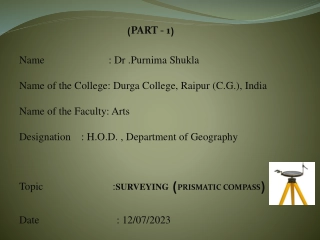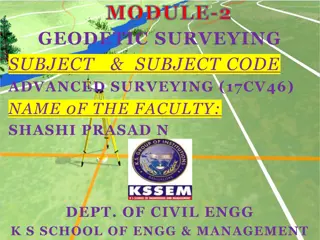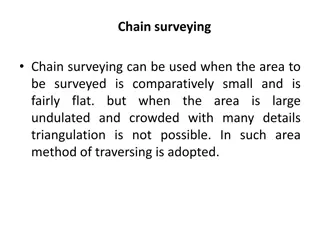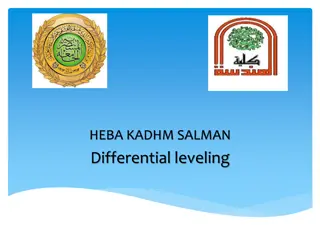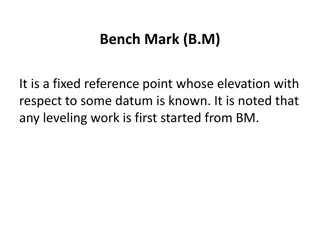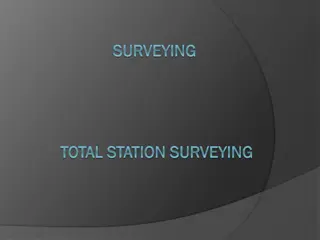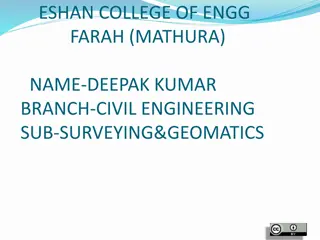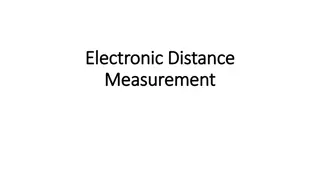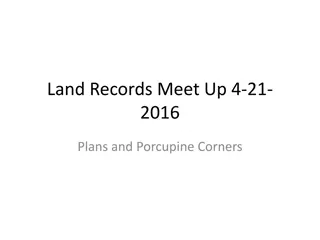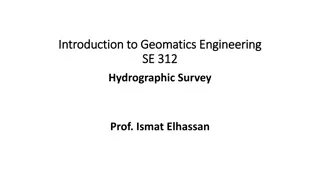Understanding the Essentials of Surveying Classification
Surveying is the art and science of determining relative positions on the earth's surface. This presentation delves into why classification of surveying is crucial, discussing the various parts of classification based on instruments, methods, purposes, and nature of the field. Through categorization, surveying processes are simplified for better understanding and application, emphasizing fundamental surveying principles.
Download Presentation

Please find below an Image/Link to download the presentation.
The content on the website is provided AS IS for your information and personal use only. It may not be sold, licensed, or shared on other websites without obtaining consent from the author. Download presentation by click this link. If you encounter any issues during the download, it is possible that the publisher has removed the file from their server.
E N D
Presentation Transcript
Presentation by, Name : Dhaval Majithiya Mechanical Department Subject: Elements of Civil Engineering Subject code: 2110004 Roll no.: 204 Amiraj College of Engineering & Technology
Contents: Surveying- definition Why classification of surveying is needed? Classification of surveying- definition Parts of classification of surveying Classification based on instruments 2. Classification based on methods 3. Classification based on purposes 4. Classification based on nature of field 1.
Definition: Surveying
Surveying is an art and science of determining the Surveying is an art and science of determining the relative positions of various points on the surface relative positions of various points on the surface of the earth. of the earth. By measuring the horizontal and vertical distances, By measuring the horizontal and vertical distances, angles and taking the details of these points and by angles and taking the details of these points and by preparing map or plants. preparing map or plants.
Definition: Classification of Surveying
Surveys can be simplified into various categories depending on the purposes, instruments, methods used and the nature of the field.
Why classification of surveying Why classification of surveying is important? is important?
So apply these rules in surveying classification is important. There are some fundamental principals of surveying that.. Always work from the whole to the part, and To locate a new stations by at least two measurements from the fixed reference points.
Mainly 4 parts of classification: Classification based on instruments Classification based on methods Classification based on purposes Classification based on nature of field
Classification based on instruments: There are mainly 9 parts of There are mainly 9 parts of classification based on instruments. classification based on instruments.
Chain survey: This is the simplest type of surveying in which only linear measurement are made with a chain or a tape. Angular measurements are not taken.
Compass survey In the compass survey, the angles are measured with the help of a magnetic compass.
Chain and compass survey: Chain and compass survey: In this survey linear measurements are In this survey linear measurements are made with a chain or a tape and angular made with a chain or a tape and angular measurement with a compass. measurement with a compass.
Plane table survey: Plane table survey: It is a graphical method of surveying in It is a graphical method of surveying in which field works and plotting both are which field works and plotting both are done simultaneously. done simultaneously.
Theodolite Theodolite survey: In this survey, the horizontal angles are In this survey, the horizontal angles are measured with a measured with a theodolite theodolite more precisely then compass and the linear measurement then compass and the linear measurement are made with a chain or a tape. are made with a chain or a tape. survey: more precisely
Tacheometry survey: A special type of theodolite known as a tacheometer is used to determine horizontal and vertical distances indirectly.
Levelling survey: This type of survey is used to determine the vertical distances and relative heights of points with the help of an instrument known as level.
Photogrammetric survey: Photogrammetry is the science of talking measurements with the help of photographs taken by aerial camera from the air craft.
EDM survey: In this type of survey, all measurements are made with the help of EDM instrument.
Classification based on methods: There are mainly 2 parts of classification cased on methods: 1. Triangulation 2. traversing
Triangulation: Triangulation is a basic method of surveying. Triangulation is a basic method of surveying. When the area is very large then, When the area is very large then, triangulation is adopted. The entire are is triangulation is adopted. The entire are is divided into a network or triangles. divided into a network or triangles.
Traversing: A traverse is a circuit of survey lines. When the linear measurements are done with a chain and tape and the directions or horizontal angles are measured with a compass or theodolite respectively, the survey is called traversing.
Classification based on purposes: There are mainly 4 types of classification based on purposes.
Geological survey: In this both the surfaces and subsurface surveying In this both the surfaces and subsurface surveying are conducted to locate different minerals and are conducted to locate different minerals and rocks. rocks. In addition, geological features of the terrain such In addition, geological features of the terrain such as folds and faults are located. as folds and faults are located.
Mine survey: Mine surveys include both the surfaces and Mine surveys include both the surfaces and underground surveys. underground surveys. It conducted for the exploration of mineral It conducted for the exploration of mineral deposits and to guide tunneling and other deposits and to guide tunneling and other operations associated with mining. operations associated with mining.
Archaeological survey: It is conducted to locate relics of It is conducted to locate relics of antiquity, civilization, kingdoms, antiquity, civilization, kingdoms, forts, temples, etc. forts, temples, etc.
Military survey: It has a very important and critical application in It has a very important and critical application in the military. the military. Aerial surveys are conducted for this purpose. It is Aerial surveys are conducted for this purpose. It is conducted to locate strategic positions for the conducted to locate strategic positions for the purpose of army operations. purpose of army operations.
Classification based on nature of field: There are mainly 3 parts of classification based on the nature of field.
Land survey: Land survey is done on land to Land survey is done on land to prepare plans and maps of a given prepare plans and maps of a given area. Topographical, city and area. Topographical, city and cadastral surveys are some of the cadastral surveys are some of the examples of land surveying. examples of land surveying.
Hydrographic survey: This survey is conducted on or This survey is conducted on or near the body of water such as near the body of water such as lake, river, coastal area. This lake, river, coastal area. This survey consists of locating shore survey consists of locating shore lines of water bodies. lines of water bodies.
Astronomic survey: The surveys are conducted for the The surveys are conducted for the determination of latitudes, determination of latitudes, longitudes, azimuths, local time, etc. longitudes, azimuths, local time, etc. for various places on the earth by for various places on the earth by observing heavenly bodies(the sun observing heavenly bodies(the sun and stars). and stars).


